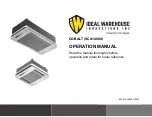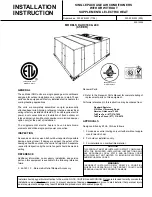
351579-YTS-B-0608
20
Johnson Controls Unitary Products
9.
Modulating Gas Heat Option
: The modulating gas heat
option uses a slave control, “MFC” Modulating Furnace
Control, that receives the heat calls from the UCB and then
controls up to 17 Steps of gas heat in a similar manner.
10.
Electric Heat Option
: The Millennium
®
Simplicity
®
control
allows staging electric heat. On units with the Electric Heat
Option, a call for heat (W1) will initiate the main supply fan.
When the
Simplicity
®
control is satisfied by the APS, it will
complete the circuit to the first stage of electric heat by ener-
gizing terminal H1. If additional heat is required, H2 will ener-
gize the second stage of electric heat [if the unit is so
equipped], and H3 the third stage [if the unit is so equipped].
All electric heat modules have an auto-reset primary limit,
monitored by the control, and non-restartable back-up lim-
its. Dirty filters, broken belts, fan motor burn-out or running
this unit below 6,000 CFM will cause the limit to trip on the
auto-reset primary limit. In addition to the primary limit,
back-up limits may trip under these conditions. The backup
limits are one-trip devices and will have to be replaced
should they trip.
When a call for heat has been satisfied, the highest stage
running will be de-energized until all are de-energized.
11.
Hot Water Heat Option
: The unit will send a 2-10 VDC sig-
nal to drive a hot water valve.
12.
Economizer Option
: The control directly controls the posi-
tion of the outside air / return air dampers through a 2-10
VDC signal from terminal ECO to ACT1 (economizer actua-
tor). The economizer is enabled only in Occupied or Recov-
ery mode, and after supply fan operation has been verified
(APS closed). When the supply fan is powered and there is
no Y1 call or if free cooling is unavailable, the control opens
the economizer dampers to the minimum position setting.
The actuator maximum opening speed is 150 seconds to
full open; the control moves the actuator at the rate of two
seconds for each one % it is opening, so full open from
closed would take 200 seconds. At entry to Occupied
mode, the economizer is typically opening from 0 to a mini-
mum setting of 20%, which would take about 40 seconds.
In Unoccupied mode, the economizer will close to 0%.
With a Y1 call when the outside air is appropriate for free
cooling (see below), free cooling is used for first stage cool-
ing. The control modulates the economizer dampers to
maintain a SAT setpoint plus or minus one degree.
The control uses one of three methods to determine when
free cooling is available. The method used is determined
by the unit options, which function as listed below.
Dry Bulb:
The control relies on the RAT, OAT, and SAT
readings, connected to those terminals on the control.
Free cooling will be available until the outdoor tempera-
ture rises above the indicated temperature range. Free
cooling is disabled when the outdoor temperature rises
above the temperature range and cannot be enabled
until the outdoor temperature falls below the indicated
temperature range.
Single Enthalpy:
The Outdoor Air Humidity Sensor is
connected to terminal OAH. When the outdoor enthalpy
is below the setpoint, free cooling is available.
Dual Enthalpy (Comparative/Differential Enthalpy):
Both the Outdoor Air Humidity [OAH] and the Return Air
Humidity [RAH] sensors are connected to the control.
When the outdoor air enthalpy is less than the return air
enthalpy, free cooling is available. The control will dis-
able free cooling and force mechanical cooling when the
outside air temperature exceeds setpoints.
13.
Power Exhaust Option with Modulating Dampers
: The
power exhaust controls are enabled in Occupied or Recov-
ery mode when the APS is satisfied. The building pressure
is sampled by a tube provided and installed by the cus-
tomer at a location in the building, connected to the high
pressure port of the pressure transducer BPS. BPS pro-
vides a 0-5 VDC signal to the control, which compares the
reading to the pressure setpoint to control the exhaust
dampers. The exhaust damper vanes are modulated by
ACT2, from a signal from terminal EXD+. The exhaust
motor is energized by voltage at terminal EXH to contactor
10M when the dampers are driven above the ON setpoint
for damper open %.
The exhaust motor is powered OFF when the vanes reach
the OFF % point set in control parameters. When the power
exhaust is disabled, ACT2's spring return closes the exhaust
dampers and 10M opens to shut down the exhaust fans.
14.
Power Exhaust Option with Variable Frequency Drive
:
The power exhaust controls are powered through EXH /
10M with a call for the supply fan. Once powered, the BPS
sensor (Building Pressure sensor) sends a signal to termi-
nal 53 of the VFD. The damper vanes are gravity-closed;
motor speed is continuously variable. See separate docu-
ment for details on power exhaust VFD operation.
15.
Non-modulating Power Exhaust Option
: The power
exhaust motor is energized by EXH / 10M based on the
position of the Economizer damper settings in the control
parameters. Minimum run time is 10 seconds; minimum off
time is 60 seconds. The outlet pressure of the power
exhaust fan forces the barometric relief dampers open;
gravity closes the dampers when the exhaust fan is off.
VARIABLE AIR VOLUME UNIT (VFD & IGV)
OVERVIEW
The VAV units operate in one of three modes: Occupied,
Unoccupied, and Recovery. The unit operational mode is
Disconnect all power supplies before checking or
servicing the electric heat section.
















































